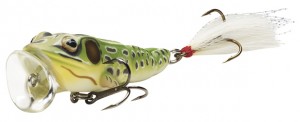June 20, 2014
By Chris Christian
Surface lures are deadly when bass come off the beds.
 Outer edges of vegetation, such as this mix of hydrilla and bonnets, become key post-spawn feeding zones.
Outer edges of vegetation, such as this mix of hydrilla and bonnets, become key post-spawn feeding zones.
Many anglers consider the spring spawning season the most excit- ing time of the year. But, when it ends, the action isn't over. The three- month period that follows may produce your biggest bass of the year—especially if you enjoy throwing topwater lures.
Spawning bass subsist largely on fat reserves built up over the fall and winter. They do little feeding during the actual spawn. Once that's over they have to eat! From April through June, bass go on a blitz to rebuild their strength and maintain an accelerated metabolism in rising water temperatures.
When bass come off the beds they are looking for the easiest meal they can get. Mother Nature provides that for them. Once bass finish spawning, panfish and forage fish move into the same general ar- eas, for their own spawning events. Some of these smaller fish become weakened or disoriented; others are injured by predato- ry birds like ospreys. You can see them flut- tering on the surface. So can the bass, and that's an easy meal.
This period of the year sees an abun- dance of prey near the surface, so it's not surprising that surface baits are deadly.
When looking for post-spawn bass, start with the areas they bedded in, and move outward. Most of the larger bass will move towards deeper water from their spawning areas, but will not yet have traveled great distances from those spawning sites. If you found spawning bass on the inside edge of a St. Johns River eelgrass bed, for instance, look for those fish on the outer portion of that grass bed. If bass were spawning along the inside edge of a hy-
drilla bed on Toho, Orange, Kissimmee, or similar lakes, the early portion of the post spawn may still see them relating to that edge, although the larger bass will be mov- ing towards the outer edge.
It doesn't take a large selection of sur- face baits to be successful. Savvy anglers will want both slow-moving and higher speed baits. In the slow moving category, there are a number of weedless soft-plastic frogs and high-floating soft plastics (like the Strike King 3X Zulu and Lizards) that can slowly pick their way over the thickest cover. For working cleaner outer cover edges, single and double prop baits (like the Devil's Horse, and similar models) are hard to beat.
On the high speed side, the new crop of “toad” baits can quickly cover even the thickest vegetation to help you find and catch bass. Frogs are great, too.
If the cover allows it, a 3/8- or 1/2-ounce metal blade buzzbait (equipped with a trailer hook) can be awesome. During the 15 years I spent as a bass guide on the St. Johns River/lake George/Rodman area, those buzzbaits produced more bass between 8 and 12 pounds than all other ar- tificial lures combined. My most effective technique was to fish into the sun early and late, along a hard outside cover edge. The low sun angle casts a lot of shade on the edge of the cover, and bass holding there are ready to ambush. Flip a noisy buzzbait into the cover and bring it over the edge. The bass hear it approach, turn their at- tention to it, but don't actually see it until it darts over the edge and moves quick- ly away from them. It's a reaction strike. You're going to react, too, when you see that big fish erupt on the bait. - FS
First Published Florida Sportsman May 2013
Summer Specials

Topwater frogs are outstanding producers in the warming days of early summer. Shown above is the new Kopper's Frog Popper. A Walk- ing and Hollow Body model are also available.
Post-spawn bass also turn their attention to the spawning beds of other fish. During the 2012 FLW Cup on Lake Lanier, Georgia, winner Jacob Wheeler twitched a perch pattern Rapala X-Rap Prop (below) over bluegill beds, catching a number of big bass that had been foraging on the panfish.


